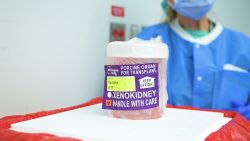Hospitals are more full than they’ve been throughout the Covid-19 pandemic, according to a CNN analysis of data from the US Department of Health and Human Services. But as respiratory virus season surges across the US, it’s much more than Covid that’s filling beds this year.
More than 80% of hospital beds are in use nationwide, jumping 8 percentage points in the past two weeks.
Hospitals have been required to report capacity information since mid-2020 as part of a federal effort to track the effects of the Covid-19 pandemic.
Hospitals have been more than 70% full for the vast majority of that time. But they’ve been 80% full at only one other point: in January, during the height of the Omicron surge in the US. Back in January, about a quarter of hospital beds were in use for Covid-19 patients. But now, only about 6% of beds are in use for Covid-19 patients, according to the HHS data.
The broader respiratory virus season is in full swing across the US. All but six states are experiencing “high” or “very high” respiratory virus as seasonal flu activity remains “high and continues to increase,” according to the US Centers for Disease Control and Prevention.
The number of people admitted to the hospital for flu during the week of Thanksgiving was nearly double the number of admissions during the week before. And the latest surveillance data probably does not reflect the full effects of holiday gatherings, as it captures only through November 26, two days past Thanksgiving.
Nancy Foster, vice president for quality and patient safety with the American Hospital Association, says that an influx of flu patients is a key reason why hospitals are filling up. On top of that are challenges brought on by work force shortages and a backlog of patients who delayed care over the past few years.
“The rates are higher because we are seeing patients with the flu in many parts of the country and that has brought a lot of older adults and some young children into the hospitals. Additionally, RSV is filling pediatric beds and cribs along with patients who are sicker now due to putting off care during Covid-19, which has required more intensive and complex care,” she said in a statement to CNN on Friday.
“Workforce shortages have not only made it more challenging for hospitals, but also have diminished the number of patients who can be cared for in nursing homes and other post acute care settings. Thus, patients are spending more time in hospitals, awaiting discharge to the next level of care and limiting our ability to make a bed available to a patient who truly needs to be hospitalized.”
In a letter to the nation’s governors last week, HHS Secretary Xavier Becerra noted that flu and other respiratory viruses are “increasing strain” on the country’s health care systems. Becerra wrote that the Biden administration “stands ready to continue assisting you with resources, supplies, and personnel” – but he stopped short of making a formal emergency declaration, as requested by children’s health leaders last month.
Hospital bed capacity can change day to day, as hospitals adjust the number of beds they make available based on staffing and other resources.
Get CNN Health's weekly newsletter
- Sign up here to get The Results Are In with Dr. Sanjay Gupta every Friday from the CNN Health team.
As of Thursday, about 10% of hospitals are reporting a “critical staff shortage.” More than 90% of hospital beds are in use in Rhode Island, and more than 85% of beds are full in eight other states: Washington, New Hampshire, Massachusetts, Minnesota, Georgia, Missouri, West Virginia and Oregon.
Pediatric hospital beds also have been more full than usual for months. About 76% of pediatric hospital beds are in use, up from an average of about two-thirds full in recent years.




















